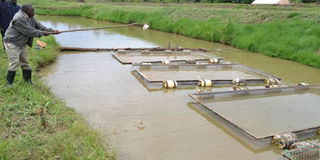New fish breeding method to help meet EU safety standards

Mwea Aquafish farm. Use of hormones in breeding of fish is being phased out in a bid to meet key market safety standards and step up production. PHOTO | FILE
What you need to know:
- The new technology, YY male tilapia technology, is based on the genetic manipulation of fish sex. Here, no hormones are applied to fish during production.
- He said the Ministry of Agriculture was also in the process of putting up a quarantine facility where exported fish will be kept before they are released to farmers.
- Aquaculture Association of Kenya Chairman Thiakunu Mwirabua noted inland fish farming was producing more fish compared to the oceans and lakes.
Use of hormones in breeding of fish is being phased out in a bid to meet key market safety standards and step up production.
Acting director, fisheries resources development and marketing, Dr Harrison Charo, has said the government would change to ‘tilapia technology’, which does not use hormones.
Dr Charo said the move is aimed at complying with European Union safety standards. The EU is the largest fish market globally.
“Over the past years, we have been preparing a residue monitoring plan so that we can have our farmed fish access that (EU) market,” he said during a ceremony to hand over a Sh60 million Kanyakine Fish Factory to Meru County Government. The plant can handle 15 tonnes of fish weekly.
“The plan has been accepted by the EU and we have to ensure our farmers comply.”
The new technology, YY male tilapia technology, is based on the genetic manipulation of fish sex. Here, no hormones are applied to fish during production.
Dr Charo said the use of hormones poses health risks.
In YY technology, one can still get mono-sex fish, which matures fast.
MORE SPECIES
“We are in the process of constructing a hatchery at Sagana-based National Aquaculture Research Development Training Centre to produce YY species. This way, we will access the EU market,” he said.
Other similar facilities are in Kakamega, Nyeri and Migori. Dr Charo encouraged fish farmers to diversify to other types of fish so as to improve production.
He said the Ministry of Agriculture was also in the process of putting up a quarantine facility where exported fish will be kept before they are released to farmers.
“This will mostly apply to farmers interested in ornamental fish which also fetches premium prices. Plans are also underway to construct a state of the art fish quality laboratory in Nairobi, with satellites in Mombasa and Kisumu to enhance residue monitoring for capture and farmed fish.
“This will enable small, medium and large-scale capture and fish farming enterprises access to markets in the EU and beyond,” he said.
County executive in charge of agriculture Kaburu M’Ribu said Meru had highly embraced aquaculture. He said the county government built 140 fish ponds in 2013 in addition to the 300 constructed under the Economic Stimulus Programme to enhance fish production.
“We will also be providing extension services to our farmers at the same time partnering with the stakeholders to increase fish production in Meru,” Mr M’Ribu said.
Aquaculture Association of Kenya Chairman Thiakunu Mwirabua noted inland fish farming was producing more fish compared to the oceans and lakes.
He attributed this to an increased demand for fish meat and products.





